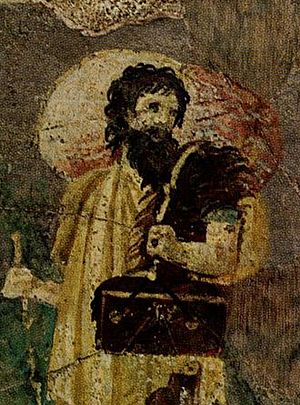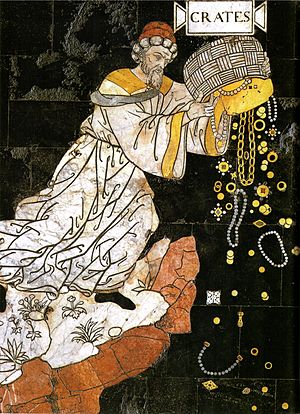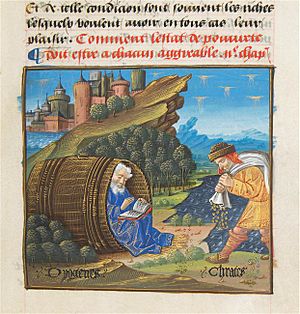Crates of Thebes facts for kids
Quick facts for kids
Crates of Thebes
|
|
|---|---|

Crates of Thebes. Detail from a Roman wall painting in the Villa Farnesina in Rome.
|
|
| Born | c. 365 BC |
| Died | c. 285 BC (aged 80) |
| Spouse(s) | Hipparchia of Maroneia |
| Era | Hellenistic philosophy |
| Region | Western philosophy |
| School | Cynicism |
|
Main interests
|
Cynicism, Asceticism |
|
Influences
|
|
|
Influenced
|
|
Crates (Greek: Κράτης ὁ Θηβαῖος; born around 365 BC, died around 285 BC) was an ancient Greek philosopher. He was from Thebes. Crates followed a way of life called Cynicism. He was a main student of Diogenes of Sinope.
Crates was married to Hipparchia of Maroneia. She also lived in the same simple way as him. Crates gave away his money. He chose to live a life of poverty on the streets of Athens. People in Athens respected him. He is remembered for teaching Zeno of Citium. Zeno later started a new philosophy called Stoicism. We still have some of Crates' ideas today. These include his thoughts on what an ideal Cynic state would be like.
Life of Crates
Crates was born around 365 BC in Thebes. His father was named Ascondus. Crates was set to inherit a lot of money. But he decided to give it all away. He wanted to live a simple, poor life in Athens. This was part of his Cynic philosophy.
There are different stories about how he gave away his money. One story says he gave it to the people of Thebes. He supposedly did this after seeing a play about a poor king. Another story says he put his money with a banker. The agreement was that the money would go to his sons. But only if they did not become philosophers. If they did, the money would be given to the poor.
Crates moved to Athens. There, he became a student of Diogenes of Sinope. Crates also studied with Bryson the Achaean and Stilpo. People said Crates had a lame leg and hunched shoulders. He was known as the "Door-Opener." This was because he could enter any home. People would welcome him with respect.

Crates met Hipparchia of Maroneia. She was the sister of one of his students. Hipparchia admired Crates and his way of life. She gave up her wealthy background, just like Crates did. Then, she married him. Their marriage was special for ancient Athens. It was based on mutual respect and equality. They had at least two children, a girl and a boy named Pasicles.
Crates taught Zeno of Citium in the late 300s BC. Crates greatly influenced Zeno in developing Stoic philosophy. Zeno always respected Crates very much. Some of the stories we know about Crates likely came from Zeno's writings. Crates also taught other students. These included Metrocles, Monimus, and Menippus. He might have also taught Cleanthes. Cleanthes later took over Zeno's Stoic school.
Crates was in Thebes in 307 BC. He died at an old age, around 285 BC. He was buried in Boeotia.
Crates' Philosophy and Ideas
According to ancient writers, Crates wrote letters about philosophy. His writing style was compared to that of Plato. There are 36 letters that people say Crates wrote. But these were likely written later, in the 1st century AD.
Crates also wrote some philosophical plays. He wrote smaller poems too, called Games. Some of his ideas still exist today.
Crates often used humor in his serious writings. This was called spoudaiogeloion. He told people to eat simple foods like lentils. He believed that too much luxury caused problems in cities. This idea often led to jokes. For example, in one ancient book, Cynics are served many bowls of lentil soup.

One of his poems made fun of a famous hymn. This hymn was written by Solon to the Muses. Crates also wrote a poem about his ideal Cynic state. This poem started by making fun of Homer's description of Crete.
In this poem, Crates used the word tuphos. This word means mist or smoke. Cynics used it to describe the mental confusion most people live in. Cynic philosophers wanted to clear away this "fog." They wanted to see the world as it truly is.
See also
 In Spanish: Crates de Tebas para niños
In Spanish: Crates de Tebas para niños


